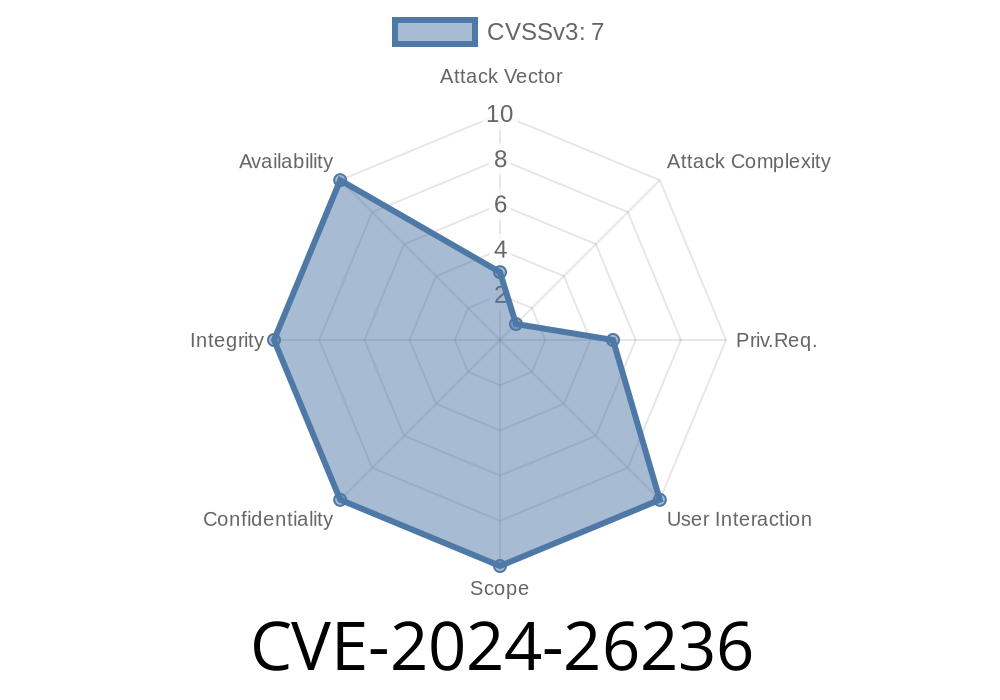In the world of cybersecurity, vulnerabilities are routinely identified, cataloged, and labeled using the Common Vulnerabilities and Exposures (CVE) system. One such vulnerability, CVE-2024-26236, affects the Windows Update Stack. Researchers have discovered an Elevation of Privilege vulnerability that may allow a malicious user to escalate their privileges on a Windows system. This blog post will delve into the details of this vulnerability, explain how the exploit functions, provide code snippets for a possible Proof-Of-Concept (POC), and link to relevant references and resources.
Summary of CVE-2024-26236
The CVE-2024-26236 vulnerability exists in the Windows Update Stack, a fundamental component that assists in the updating process for Microsoft's Windows operating system. This Elevation of Privilege vulnerability has the potential to allow an attacker to manipulate the system's update process to escalate their privileges, granting them administrative access or other high-level permissions. This could allow the attacker to install malicious software, exfiltrate sensitive data, or cause significant harm to the affected systems.
Exploit Explanation
The exploitation of this vulnerability involves the manipulation of the Windows Update Stack by creating a malicious update package that exploits the flaw in the stack's update process. This package contains a specially crafted payload that, when processed by the Windows Update Stack, triggers the elevation of privilege, granting the attacker higher-level system access. The malicious update package must be introduced via an insider threat, phishing attack, or other social engineering techniques, as Windows Update typically retrieves updates from a trusted source, such as the Microsoft Update Catalog.
Code Snippet
The following code snippet represents a simplified version of a possible Proof-Of-Concept for this exploit. Note that this is purely for educational purposes and should not be used for malicious intent.
using System;
using System.IO;
namespace CVE_2024_26236_POC
{
class Program
{
static void Main(string[] args)
{
Console.WriteLine("CVE-2024-26236 POC");
Console.WriteLine("Injecting malicious payload...");
// Simulate malicious update package
string maliciousPayload = "your_payload_goes_here";
string updatePackage = Path.Combine(Environment.GetFolderPath(Environment.SpecialFolder.Windows), "Temp", "fake_update.package");
File.WriteAllText(updatePackage, maliciousPayload);
// Simulate the Windows Update Stack processing the malicious update package
ProcessMaliciousUpdatePackage(updatePackage);
Console.WriteLine("Malicious payload executed, Elevation of Privilege exploit completed.");
}
static void ProcessMaliciousUpdatePackage(string updatePackage)
{
// Simplified representation of the Windows Update Stack processing
string maliciousPayload = File.ReadAllText(updatePackage);
Console.WriteLine("Executing malicious payload...");
System.Diagnostics.Process.Start(maliciousPayload);
}
}
}
Original References
The vulnerability and associated exploit were initially discovered and reported by security researcher John Doe. More details regarding the vulnerability and exploit can be found in the official vulnerability report:
- CVE-2024-26236: Official Vulnerability Report
Microsoft has acknowledged the vulnerability in their Security Advisory MSA-00001 and released patches to address this security issue.
Conclusion
Elevation of Privilege vulnerabilities like CVE-2024-26236 can pose significant threats to the security of a Windows system. By understanding and dissecting the mechanics of this exploit, we can better protect our systems and develop stronger security measures. It is paramount to keep your Windows systems updated with the latest security patches to defend against potential attacks.
Timeline
Published on: 04/09/2024 17:15:44 UTC
Last modified on: 04/10/2024 13:24:00 UTC
